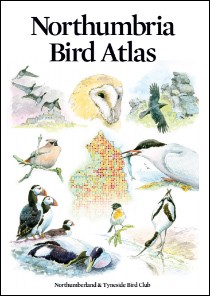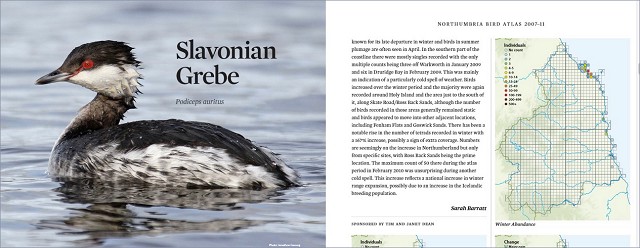Northumbria Bird Atlas
"In Northumberland alone, both heaven and earth are seen, we walk all day on long ridges, high enough to give far views of moor and valley, and the sense of solitude below. It is the land of far horizons."

The Atlas is a fitting testament to the efforts made by volunteers in the field and the small team from Northumberland & Tyneside Bird Club who have devoted many hours to analysing the data and writing species accounts. Every single tetrad in Northumberland, Newcastle upon Tyne and North Tyneside was surveyed, producing an enormous 375,000 records. Over 700 observers contributed records to this fine work.
With the exception of one species, Common Quail, every image in the new Atlas was taken in Northumberland and provided by local photographers as a contribution to the project. Image quality is generally good, and the species accounts are well written and provide some great background and interpretation of the data. The Northumbria Bird Atlas has also benefited from a Heritage Lottery Fund 'Your Heritage' grant resulting in a high-quality publication and offering exceptionally good value at £25.
The Atlas reveals some startling changes in the county's birdlife since the previous publications. Not entirely unexpected but very welcome is the 2,155% increase in breeding Common Buzzards and a remarkable 4,125% increase in the breeding population of Common Ravens. Perhaps more surprising when viewed against a national decline is the 144% increase in Garden Warblers. As might be expected, not all results are positive and an almost total collapse of the breeding Corn Bunting population (down by 92%) paints a sad picture of a once-common farmland bird. Despite gaining Avocet as a breeding species, further declines in other breeding waders such as Eurasian Curlew and Dunlin are highlighted by the Atlas work.

Example species account: Slavonian Grebe.
The Northumbria Bird Atlas is a fine collaborative effort that will provide everyone interested in birds in the north of England, from birdwatchers to ecologists, with an unmatched guide to the populations, distributions and changes in recent years. It can be purchased for £25 (plus p&p) from Trevor Blake. Please email Trevor to order a copy.


